

states and towns were given the choice of whether or not to observe DST led to chaos. 9, 1942, President Franklin Roosevelt re-established daylight saving time year-round, calling it "War Time."Īfter the war, a free-for-all system in which U.S. (It's a myth that DST was instituted to help farmers.) And so daylight saving time was abolished until the next war brought it back into vogue. Though President Woodrow Wilson wanted to keep daylight saving time after WWI ended, the country was mostly rural at the time and farmers objected, partly because it would mean they lost an hour of morning light.

(Image credit: Topical Press Agency/Getty Images) And in 1918, the United States adopted daylight saving time. The rest of Europe came onboard shortly thereafter. Germany established DST in May 1916, as a way to conserve fuel during World War I. At the time, Franklin was ambassador to Paris, and he wrote a witty letter to the Journal of Paris in 1784, rejoicing over his "discovery" that the sun provides light as soon as it rises.Įven so, DST didn't officially begin until more than a century later. By moving clocks forward, people could take advantage of the extra evening daylight rather than wasting energy on lighting. Why did daylight saving time start?īenjamin Franklin takes the honor (or the blame, depending on your view of the time changes) for coming up with the idea to reset clocks in the summer months as a way to conserve energy, according to David Prerau, author of " Seize the Daylight: The Curious and Contentious Story of Daylight Saving Time" (Thunder's Mouth Press, 2005). will begin again on March 13, 2022, and it ends on Nov. 7 in the U.S., when most Americans set the clock back an hour, and the cycle will began again.


 0 kommentar(er)
0 kommentar(er)
